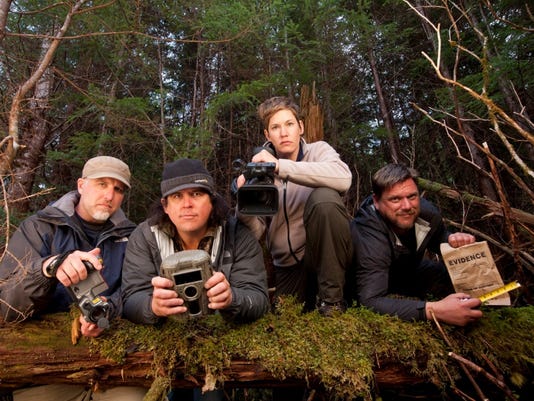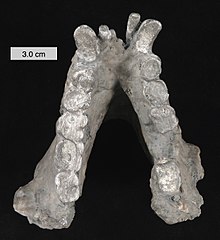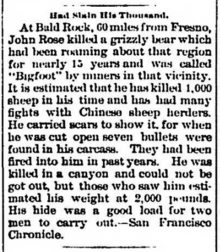Finding Bigfoot ? A Comedy? or A Show?
緣由
 |
| Cliff Barackman, James "Bobo" Fay, Ranae Holland and Matt Moneymaker lead the search for Sasquatch on Animal Planet's "Finding Bigfoot." |
我是信科學的人,在沒找他她是假的證據前都不能說她是偽照的,騙取觀光財。但是我實在覺得這節目裡的這些人是來曝光賺錢的。呵呵!
在我部落格的閱讀者就參考我給的連結讀吧。[7][8][9][10]
What is this drama?
Finding Bigfoot is a documentary television series on Animal Planet. It premiered on May 29, 2011. The program follows four researchers and explorers investigating potential evidence of Bigfoot, a cryptid hominid allegedly living in the wildernesses of the United States and Canada. While the Finding Bigfoot team have not yet captured photographic evidence of the creature's existence, the show continues production because it has high ratings and is a top earner for Animal Planet. The series finale and the 100th episode was released on May 27, 2018.
What is Big foot???
 |
| Fossil jaw of the extinct primate Gigantopithecus blacki |
According to David Daegling, the legends existed before there was a single name for the creature. They differed in their details both regionally and between families in the same community.Ecologist Robert Pyle argues that most cultures have accounts of human-like giants in their folk history, expressing a need for "some larger-than-life creature." Each language had its own name for the creature featured in the local version of such legends. Many names meant something along the lines of "wild man" or "hairy man", although other names described common actions that it was said to perform, such as eating clams or shaking trees. Chief Mischelle of the Nlaka'pamux at Lytton, British Columbia told such a story to Charles Hill-Tout in 1898; he named the creature by a Salishan variant meaning "the benign-faced-one".Members of the Lummi tell tales about Ts'emekwes, the local version of Bigfoot. The stories are similar to each other in the general descriptions of Ts'emekwes, but details differed among various family accounts concerning the creature's diet and activities. Some regional versions tell of more threatening creatures. The stiyaha or kwi-kwiyai were a nocturnal race. Children were warned against saying the names, lest the monsters hear and come to carry off a person—sometimes to be killed. In 1847, Paul Kane reported stories by the Indians about skoocooms, a race of cannibalistic wildmen living on the peak of Mount St. Helens in southern Washington state.Less-menacing versions have also been recorded, such as one by Reverend Elkanah Walker from 1840. Walker was a Protestant missionary who recorded stories of giants among the Indians living near Spokane, Washington. The Indians said that these giants lived on and around the peaks of nearby mountains and stole salmon from the fishermen's nets.In the 1920s, Indian Agent J. W. Burns compiled local stories and published them in a series of Canadian newspaper articles. They were accounts told to him by the Sts'Ailes people of Chehalis and others. The Sts'Ailes and other regional tribes maintained that the Sasquatch were real. They were offended by people telling them that the figures were legendary. According to Sts'Ailes accounts, the Sasquatch preferred to avoid white men and spoke the Lillooet language of the people at Port Douglas, British Columbia at the head of Harrison Lake. These accounts were published again in 1940. Burns borrowed the term Sasquatch from the Halkomelem sásq'ets (IPA: [ˈsæsqʼəts]) and used it in his articles to describe a hypothetical single type of creature portrayed in the local stories.The name "Big Foot" first gained renown by a Wyandot chief with that nickname in the 1830s "who derived his name from the immense size of his feet. His height considerably exceeded six feet, and his strength was represented as Herculean. He also had five brothers, but little inferior to himself in size and in courage, and as they generally went in company they were the terror of the country." Later in the 19th century Spotted Elk was also called Chief Big Foot; he was a well-known Lakota leader killed during the Wounded Knee Massacre in 1890. The two Indians may have been the namesakes for two fabled bears in the West. In the late 19th and early 20th centuries, at least two enormous marauding grizzly bears were widely noted in the press and each nicknamed "Bigfoot". This may have inspired the common name of the ape-creature and been a matter of confusion in early stories.The first grizzly bear Bigfoot was reportedly killed near Fresno, California in 1895 after killing sheep for 15 years; his weight was estimated at 2,000 pounds (900 kg). The second one was active in Idaho in the 1890s and 1900s between the Snake and Salmon rivers, and nearly supernatural powers were attributed to it.
Significant evidence
The evidence that does exist supporting the survival of such a large, prehistoric ape-like creature has been attributed to hoaxes or delusion rather than to sightings of a genuine creature. In a 1996 USA Today article, Washington State zoologist John Crane said, "There is no such thing as Bigfoot. No data other than material that's clearly been fabricated has ever been presented." In addition, scientists cite the fact that Bigfoot is alleged to live in regions unusual for a large, nonhuman primate, i.e., temperate latitudes in the northern hemisphere; all recognized apes are found in the tropics of Africa and Asia.[5][6]
Mainstream scientists do not consider the subject of Bigfoot an area of credible science and there have been a limited number of formal scientific studies of Bigfoot.
Evidence such as the 1967 Patterson–Gimlin film has provided "no supportive data of any scientific value".
As with other similar beings, climate and food supply issues would make such a creature's survival in reported habitats unlikely. Great apes have not been found in the fossil record in the Americas, and no Bigfoot remains are known to have been found. Phillips Stevens, a cultural anthropologist at the University at Buffalo, summarized the scientific consensus as follows:It defies all logic that there is a population of these things sufficient to keep them going. What it takes to maintain any species, especially a long-lived species, is you gotta have a breeding population. That requires a substantial number, spread out over a fairly wide area where they can find sufficient food and shelter to keep hidden from all the investigators.
The lack of good evidence hasn't dampened the enthusiasm of Bigfoot buffs; they have all they need in sighting reports, fuzzy photos, inconclusive hair samples, and footprints to keep the search going. Until better evidence comes along, old evidence will be rehashed and re-examined — and unless Bigfoot is proven to be alive, the search will continue. [7]
延伸閱讀
參考文獻
- Bigfoot - Wikipedia
- IMDB
- Finding Bigfoot
- Animal Planet seeks locals for 'Finding Bigfoot'
- Bigfoot [a.k.a. Abominable Snowman of the Himalayas, Mapinguari (the Amazon), Sasquatch, Yowie (Australia) and Yeti (Asia)]
- Hunt for Bigfoot Attracts True Believers.
- Bigfoot: Man-Monster or Myth?
- News: Did Hiker Film Bigfoot, Black Bear or 'Blobsquatch'?
- We Asked the Hosts of Finding Bigfoot Why It's Taking So Damn Long

留言